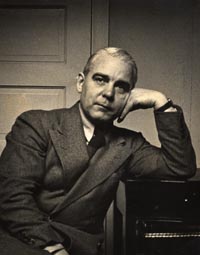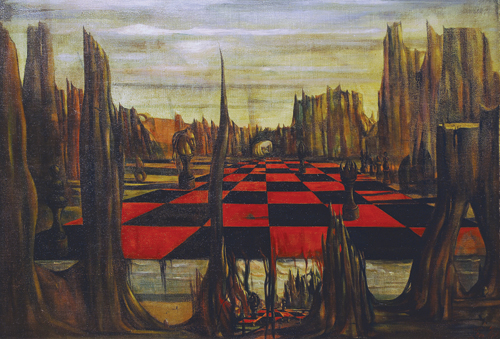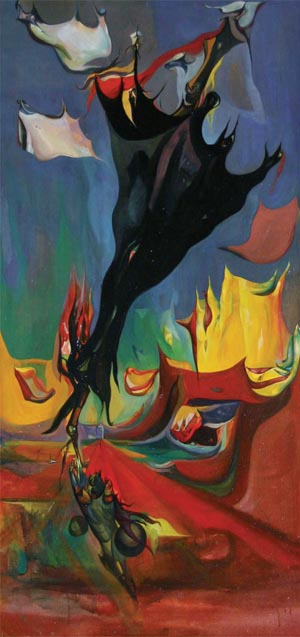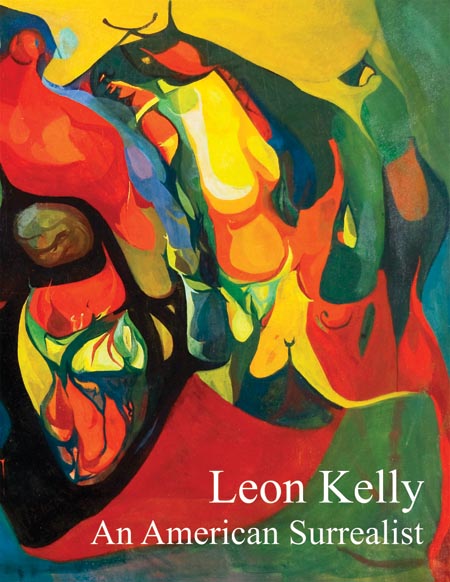![[Francis Naumann]](/4logo.gif)


“Closed in the chrysalis of his art” is the apt phrase Leon Kelly’s friend and dealer, Julien Levy, used to describe the artist. It is an oblique reference both to the bizarre insects which populated so many of his paintings and drawings and to the hermetic environment in which he lived and worked for half his life. When he died in 1982, Kelly had been living for forty years on a sand spit of an island off the New Jersey coast… It follows that the art that came from this inward-turned artist, living in relative isolation, would have a self-contained quality that set it apart from the contending -isms of modern art and from the reverberations of the nascent abstract expressionism that attracted his contemporaries.

Oil on canvas, 14 1/2 x 20 inches

Leon Kelly (1901-1982) is a major American Surrealist painter, who, due to an innately reclusive disposition, died in comparative obscurity. In the 1940s, however, he was known and recognized for a style of painting that virtually defined Surrealism. His visual flights of fancy—birds, insects and extraterrestrial beings—were rendered in a style so elaborate and precise that viewers could easily believe these magical creatures actually existed. He was born and raised in Philadelphia. An innate talent for drawing earned him a scholarship at the Pennsylvania Academy and a traveling fellowship for study in Europe, where he copied old-master paintings in the Louvre and developed the academic techniques he would carry over to his more experimental, modernist work. During the 1930s, he exhibited frequently in Philadelphia and was regarded as part of the avant-garde group that formed around the painter Arthur B. Carles.
A crucial event for Kelly was his discovery by Julian Levy, a prominent art dealer in New York who became a strong supporter, showing his work in his gallery and providing a monthly stipend in exchange for work. Kelly’s closest aesthetic affiliation lies with the European Surrealists he encountered at the Julien Levy Gallery: Max Ernst, Salvador Dalí, Yves Tanguy, André Masson, Pavel Tchelitchew and Eugene Berman. It was also through the gallery that Kelly met a number of American artists who would become notable in years to come, Joseph Cornell and Arshile Gorky among them. To varying degrees, all of these artists influenced the style of Kelly’s work, although its subject matter was drawn from sources that he encountered independently, whether it be the birds and insects in his island environment, Peruvian textiles he had seen on display at the Brooklyn Museum, Native American pottery he discovered when visiting reservations in Wyoming and New Mexico, or scenes inspired by several sojourns of residence in Europe. All of these sources found their way into his paintings and drawings of the 1950s and 1960s, many of which were executed on a grand scale—some canvases measuring as much as 6 x 8 feet—as if to rival the accomplishments of contemporary abstract painters. No matter what their size and subject, Kelly’s later paintings continued to be characterized by an innate talent for rendering, while they remained indebted to the liberating impact of Surrealism, which had opened the way for the development of his unique style.
Oil on canvas, 51 x 24 7/8 inches
The exhibition is accompanied by the first major monograph on Leon Kelly, containing an introductory text by the noted scholar and historian of Surrealism, Martica Sawin, and a detailed chronology of his life, featuring transcriptions from an unpublished autobiographical account, as well as photographs and exhibition reviews from Kelly’s private scrapbook. Also over 50 color reproductions.
Price: $45 plus shipping.
